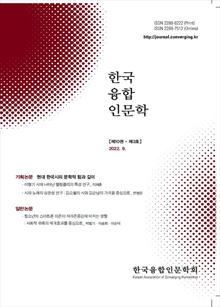간행물
융합인문학 KCI 등재 Korean Journal of Converging Humanities

- 발행기관 한국융합인문학회
- 자료유형 학술지
- 간기 연3회
- ISSN 2983-0451 (Print)2983-0893 (Online)
- 수록기간 2013 ~ 2022
- 주제분류 인문학 > 기타인문학 인문학 분류의 다른 간행물
- 십진분류KDC 331DDC 301
권호리스트/논문검색
제4권 제2호 (2016년 9월) 4건
1.
2016.09
구독 인증기관 무료, 개인회원 유료
This paper aims to examine the significance of xenophobia and hate crimes in multicultural societies. It begins with outlining the general discussions about multiculturalism, xenophobia and hate crimes. It identifies hate crimes that related to xenophobia in multicultural society and introduces hate crime laws in Australia. While Australian multicultural policy has its roots in government responses to the post‐settlement issues facing migrants, through the 1980s and 1990s policy was articulated more broadly as an element of Australia's nation building narratives. Today all Australian States and Territories have active policies and programs dealing with multiculturalism. As other multicultural societies, Australia confronts with challenges in building a multicultural society. One of them is xenophobia and hate crimes related to race, ethnic, religions. A number of common law countries have introduced legislation designed to respond to the problem of prejudice-related crime, commonly referred to as hate crime law. Whilst the heavier penalties imposed by hate crime laws are designed to denounce, and thereby deter, prejudice-related violence, it is apparent that these laws are meant to do more than punish and deter. They aim to condemn, not just criminal conduct per se, but also racism, homophobia, religious intolerance and the like. In this way Australia seek to make a broad moral claim that prejudice is wrong and to thereby reinforce pro-social values of tolerance and respect for marginalized and disadvantaged groups. This paper argues that hate crime laws are necessary in order to prevent hate crimes related to multiculturalism and suggests that Australian hate crime laws can be implied to sustain multiculturalism in Korea
6,000원
2.
2016.09
구독 인증기관 무료, 개인회원 유료
The topic of school bullying has been seriously reported and discussed in Korea from the mid-1990s, with the several suicidal cases of bullying victims were reported. Korean government has dealt systematically with the problem of school violence and bullying, and established a series of corresponding system that covers prevention, reporting, and follow-up of a school violence act. This study purports to review the development of Korea's school anti-bullying policies and investigate their limitations as a process evaluation. After the School Violence Act was enacted in 2004, several countermeasures has been arranged systematically. The legislation stipulated that victims must report their cases to the school authorities or the police, and school districts are mandated to organize an Autonomous School Violence Solution Committee. The 117 School Violence Report Center was enlarged and School Police Officer program was adopted. The prevalence rate of school violence in Korea had been decreased after 2012. It can be said that the overall occurrence of school violence have reduced but school violence still occurs among a significant portion of students. Even if visible incidence of school violence has decreased, not only the emergence of new types of school violence but also the invisibility and severity of school violence can be strengthened. And in dealing with the school violence cases, the ambiguity of the criteria on the identification of school violence and bullying and arbitrariness of decision making process can be problematized. The judgments on punishment should be made in precluding the arbitrariness of individuals as much as possible and in accordance with the unified detailed instructions. In order to execute the anti-bullying policy more effectively, there is a need to pay attention to the problems that appeared in its policy implementation processes.
5,400원
3.
2016.09
구독 인증기관 무료, 개인회원 유료
This article aims to critically examine gender inequality in the domestic labor which is the biggest obstacle to building a gender equal society in the 21st century. Gender inequality in the domestic labor is basically attributable to gender division of labor. Gender division of labor neglects the socioeconomic value of domestic labor, and takes the unpaid domestic labor of women for granted. However, it is unavoidable that this trend cannot continue in an aging and low fertility society. This is because it contradicts to not only the various social systems but also to the basic directions of social policies in an aging and low fertility society. This article reviews the causes and actualities of gender inequality in the domestic labor with a focus on gender
5,400원
4.
2016.09
구독 인증기관 무료, 개인회원 유료
Cultural industry has grown into a pivotal part of the knowledge economy and it characteristically allows high employment of young population with high education and at the same time is a labor-intensive industry that yields high added values. For these reasons, it has been regarded as an industry that can be an answer to ever worsening problems of youth unemployment and deteriorating employment quality in the service industry sector. The Korean government has established and enacted government-level supporting policies to foster the cultural industry, especially in the 2000s. In the process, a supporting system for start-up businesses in the cultural industry was implemented to foster one-person culture businesses, focusing on the supporting system for start-up businesses established by the Small and Medium Business Administration (SMBA). This study will look into possible solutions to some problems that occurred in the course of implementing supporting policies for cultural industry and will see if there could be alternatives to them.
4,900원

